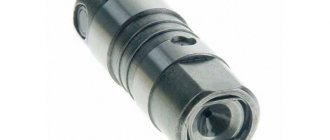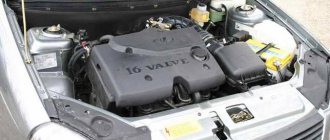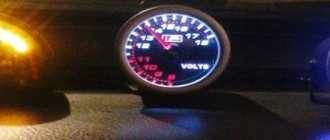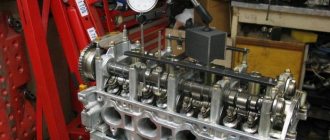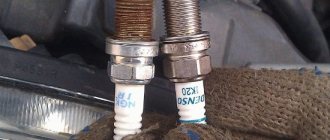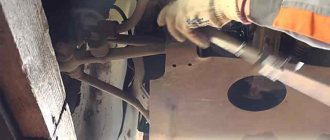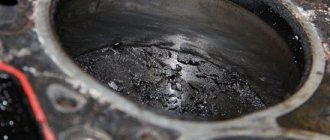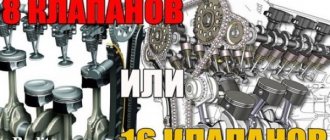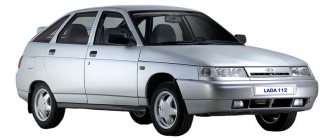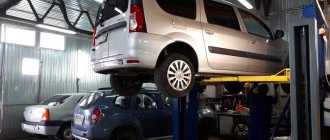Basics of the design and operation of a hydraulic compensator
Configuration
The idea of automatic regulation of thermal clearances can be implemented in two versions: a conventional hydraulic pusher and a hydraulic support. The latter is used in gas distribution modules with rocker arms. On the Lada Priora in the sixteen-valve version, the intake and exhaust are equipped with individual camshafts. The optimal solution for this arrangement is the use of a hydraulic pusher.
The Priorov hydraulic compensator on the 126 engine consists of the following parts:
- A plunger pair, including a cylindrical cage and a piston with a ball valve.
- The outer housing is a pusher.
- System of grooves and holes for oil supply.
Principle of operation
The oil composition enters the internal cavity of the piston and, overcoming the resistance of the spring, pushes the ball away to fill the closed cylinder. When filling the liner, oil pushes the piston out and the hydraulic tappet rests against the cam. Next, the ball valve is locked and the assembly unit works like a regular pusher on motors with an adjustable valve mechanism.
Constant knocking
Diagnostics and repair
Why do hydraulic lifters knock on the Lada Priora and what to do in this case
First of all, it is worth determining which specific hydraulic pusher is not working correctly, and whether they are the cause of the unpleasant sound. This can be done using acoustic diagnostics or by turning off the engine cylinders alternately. For this, it is advisable to contact a car service or do it yourself. However, trying out repair methods yourself can be more expensive than calling an experienced engine specialist.
Then you need to check the oil pressure in the engine system for compliance with the standards. If it is lower than necessary, then the oil pump or filter may need to be replaced.
Often the cause of incorrect operation of the mechanism is engine oil, which was chosen incorrectly or is present in insufficient quantities. It is necessary to change it to another brand, change its viscosity or add special additives to it that eliminate the knocking of hydraulic pushers.
Sometimes you may notice that oil appears in one of the spark plug wells when the engine is running under heavy load. You need to pull it out with a syringe and clean the spark plugs. Then, to create the required pressure in the system, under the cover of the hydraulic compensators and heads, you need to apply sealant, which was “greedy” when assembling the car at the manufacturer.
Hydraulic pushers do not need any adjustment, since they themselves are able to adapt to the operating mode of the mechanisms.
How to eliminate the knocking of hydraulic pushers on Lada Priora
Timely and high-quality maintenance of the engine oil system is the key to flawless operation of the hydraulic compensator mechanism. After all, the unit is designed for use throughout the entire resource of the power plant.
Use of recommended lubricant
When the hydraulic pushers just start knocking, the manufacturer recommends changing the lubricant to a proven option. Therefore, when the question arises of what kind of oil to pour in principle, it is worth analyzing reviews to determine the acceptability of a certain model of oil product for hydraulic compensators.
Of course, the best choice for Lada Priora will be the composition recommended by the manufacturer, specified in the instruction manual. However, not all current popular products are included in the list.
An analysis of opinions shows that, indeed, with the universal viscosity of 10W-40 or 5W-40 specified by the factory, not every oil is suitable. For example, Shell Helix Ultra 5W-40 causes knocking already at 15,000 km, while on Liqui Moly Optimal Synth 5W-40 the hydraulics are silent even at 80,000 km.
Reviews show that it is optimal to choose the following lubricants:
- Total Quartz 9000 Energy 5W-40.
- Mobil Ultra 10W-40.
- Wagner Windigo 10W-40.
Flushing
Many owners, in advanced cases, resort to general engine flushing. However, the effectiveness of such an event in the fight against knocking GCs is low. This is explained by poor oil pumpability in the area of the hydraulic pusher chambers. If changing the lubricant does not help, the best solution is to remove the cylinder head cover and find which hydraulic compensators on the Lada Priora 16-valve engine are knocking and determine the reason for this. Defective parts are identified by diagnosing running resistance with a wooden wedge. A fast movement speed in comparison with other hydraulic supports indicates wear of the hydraulic module, the presence of a constant gap indicates its coking.
Attention! The wooden wedge must be pressed against the non-working surface of the cams.
Effective removal of carbon deposits inside the cylinders is their local washing. Worn assembly modules cannot be repaired.
Additives
Additive compounds help delay identifying the causes and cleaning the timing belt. There are several products available in the market. The most popular products are from Liqui Moly and XADO. The effectiveness of substances depends on the specific case. Fans of motor additives often equate this class of chemistry with a waste of money.
What to look for when choosing
When choosing a new consumable, you should pay attention to key characteristics. Knowing the basic parameters will allow you to find the optimal part that suits your specific needs.
Length
The ride height depends on the length. Typically, the manufacturer mentions the recommended clearance value in the technical documentation of the model. In rare cases, the spring lengths of the rear and front axles may differ. But it is advisable not to deviate from the technical parameters from the manufacturer. These parameters are determined by precise technical calculations.
You can deviate from the recommendations in two cases:
- “pumping” the car for the sake of visual customization
- modernization of the chassis for transporting heavy loads
Rigidity
The degree of rigidity determines the behavior of the car on the road and distributes the load across the remaining suspension elements. Soft springs are suitable for comfortable, smooth rides, while hard springs cope well with high loads. Therefore, the choice of rigidity largely depends on the purpose of using the machine.
Among owners of VAZ cars (including the Seven), there is a common problem with purchasing new consumables for their “swallow”. In a single set from one manufacturer, sometimes there are elements with different degrees of rigidity. Unfortunately, it is impossible to know about this in advance, and the body defect appears during use.
To resolve the issue, car owners resort to one of two methods. The first option involves purchasing another pair, usually foreign-made. The second method involves installing spacers.
A spacer is a rubber lining that is placed under the seating area of the “glass”. This method will significantly save the budget of the owner of the Lada.
The degree of spring stiffness depends on several indicators:
- The thickness of the rod section. A simple law applies here: the thicker the rod, the higher the level of rigidity. However, there are models with different ring diameters, and therefore the rule applies only to classic straight models.
- Total diameter of turns. Increasing the width of the rings leads to increased softness.
- Number of turns. The higher the number of revolutions of the rod, the lower the rigidity of the part.
Turning parameters
The main characteristics include two indicators: the number of turns and the thickness of the section. They determine the final degree of rigidity of the part.
It is not uncommon to find original springs with different ring diameters. Externally, they have an oval shape: wide in the middle with a gradual decrease towards the edges. The different diameters of the rings are also made of metal of different thicknesses. For massive turns, a thick rod is used, and the small rings on the sides are made of thin material. This design feature gives it versatility: it dampens small vibrations and large shocks equally well.
But the main “disease” of these models is hidden in the extreme turns. Due to the small thickness of the metal, the side parts of the part are very fragile, and therefore often break on uneven roads. This is the price of comfort: for a soft ride you have to pay for frequent repairs.
An alternative to factory springs is products from third-party manufacturers. A non-original product is made from a rod with a constant cross-section. This negatively affects ride comfort due to high rigidity. But non-original consumables are distinguished by their reliability and durability.
The springs of the shock-absorbing system are conventionally divided into 5 categories, which can be presented in table form:
When do you need to replace hydraulic compensators on a Priora?
How to determine that the hydraulic compensators on a Priora need to be replaced?
A clear sign that one of the 16 hydraulic compensators has failed is the presence of a knocking sound in the engine. This knocking noise may appear on a cold start and disappear when the unit is warm. If the engine is knocking, then it is certainly better to have it rebuilt and checked to understand why there is an alien sound coming from the engine. But the reason why hydraulic compensators knock on a cold engine may also be that they simply do not contain oil. After a couple of minutes, the knocking of the hydraulic compensators usually disappears and does not recur until the next cold start.
When compensators knock on a hot engine, replacing them can no longer be avoided. Whatever the stated service life of these consumables, they have already expired. If the hydraulic compensators knock on a warm or cold engine, but only when the speed increases, it means that there is a lot of oil in the engine or the oil filled is too thin for such a unit. The solution to this problem is to bleed off the excess amount of lubricant or fill in the recommended brand of oil. After this procedure, the extra sounds on the Priora will disappear.
If there is a sound similar to the knock of a single hydraulic pusher, the cause may be contaminated hydraulic compensators on the Priora. When flushing, an oil change is inevitable. The procedure for assembling and disassembling the engine is similar to the replacement operation when the hydraulic compensators knock.
Causes of problems
The knocking noises are clearly distinguishable when the unit is cold and when the engine is already warm. The reasons for cold knocking are:
- It can be caused by too thick oil, which is not heated, and therefore is poorly pumped into the compensator cavity. It happens too slowly when cold and a knocking noise occurs.
- If the compensator valve or line is clogged with dirt. Such contamination usually occurs when the oil is of poor quality, or when a timely oil change is missed. Clogging may occur due to the appearance of chips and other wear products of motor elements.
- Jammed compensator plunger. This happens due to abrasive debris getting into the oil, or natural wear of the part.
- There is a lack of oil in the engine; there is simply not enough of it for normal operation.
Now let's look at the reasons for knocking on a hot Priora:
- A jammed hydraulic compensator pair due to contamination or wear. The resulting scuffs block the movement of the plunger. The gap is not compensated for and knocking noises appear. Such a knock will be heard both with a cold and hot engine.
- Low viscosity of heated oil. When the lubricant is too liquid, it manages to flow out faster than the pump pumps it into the compensator. The leaking oil does not allow the cylinder to expand and the gaps are not compensated. The reason is poor-quality oil, or a mistake by the owner himself with the viscosity of the lubricant.
- The oil foamed due to too much oil, water getting into it, or poor quality.
- Camshaft problems.
If you hear such sounds, immediately check the oil level and color. Adjust the high or low level to normal, this may solve the problem. By the color of the oil, you can understand the degree of contamination and remember that you missed changing it. Oil mixed with water becomes gray or rusty, this will be noticeable on the dipstick.
How to change hydraulic compensators on a Priora with your own hands?
How to change hydraulics?
Replacing hydraulic valves with your own hands is done without much difficulty. If you have a Priora, the knocking sound of its engine really irritates the owner, and having money doesn’t put too much pressure on your pocket, but you still have time for creativity and expression of ambition, you can try yourself as a car mechanic.
Replacing hydraulic valves with your own hands is best done on a “cold” machine.
After letting the engine sit for about a day, let the oil drain into the oil pan and minimize its presence in the upper part of the engine.
In order to get to the cylinder block where the hydraulic compensators are located, you must:
- disconnect the car;
- remove the terminals from the battery;
- disconnect all wires and hoses that interfere with the process;
- Disconnect the air conditioning line if there is one in the car.
To remove the cylinder head, you need to get to a very inconveniently located bolt, which can only be unscrewed after removing the timing belt, which is also not an easy task. If it is necessary to replace it, then it is advisable to do this at the same time.
After removing the cylinder head cover, access to the hydraulic compensators will be practically open; all that remains is to remove the camshafts.
It is possible to check the functionality of compensators without removing them from their sockets. To do this, you need to press hard on each cylinder: if you encounter resistance and virtually no deformation, then the compensator is in order and can be left. If a weak link is identified, that is, an element that fails when pressed, its replacement is mandatory. Experts recommend replacing the entire set, since it is not possible to check the degree of wear of the remaining hydraulic compensators.
Removing parts from their sockets is a fairly simple operation for the initiated. This is usually done using a magnet on a long handle. We change the entire set, install the camshafts, fix them in their places with bolts.
The cover on the Priora is attached tightly to the cylinder block; rubber gaskets are not used for this; it is recommended to use a sealant. All wires and hoses are laid in their interfaces, and the terminals are placed on the battery. Now the car will amaze the owner with the “whisper” of engine operation with new hydraulic compensators.
The steering rack is a quiet separate element with sophisticated diagnostics
It often happens that after reassembling the entire chassis, it is time to check the steering rack. By moving the steering wheel left and right, you will hear small knocks if the rack has already begun to wear out. But this does not mean at all that it knocks during operation. It is difficult to give general recommendations here; there are different recommendations for owners of different cars:
- It’s worth visiting specialized forums and reading information about how and when the steering rack fails, how you can check and fix it;
- tightening the steering rack is a solution for a few days; soon it will start knocking again if a problem is identified with this particular element of the car;
- the knock of the rack is often a distinct feedback on the steering wheel, as well as on the body in the area where the control pedals are attached, so diagnosis will not be difficult;
- Sometimes steering tips or rods knock, which is more difficult to check, but you can perform a full diagnosis in a pit without any problems or inaccuracies.
The steering system likes to knock in domestic cars, as well as in cars older than 10 years. Changing the steering rack is very difficult due to the high cost of spare parts and the rather inconvenient location in many cars. Therefore, they prefer to perform this process on a service. Professionals will complete all tasks quite simply and quickly.
Everything should be nearby, don’t start without preparation
Lada Priora can serve as an example to consider the replacement process. To avoid unpleasant surprises, any work must be planned and everything necessary must be prepared. In our case we will need:
- Gasket Maker - sealant (anaerobic);
- camshaft plugs and seals;
- 16 INA compensators.
Let's start by disconnecting the battery minus. Then we dismantle the air filter, throttle cables, wires that will interfere with manipulation, injector ignition coils and intake manifold.
Replacing hydraulic compensators on a Priora is complicated by the fact that the manifold mounting bolt is located under the generator.
To get to the hydraulic compensators:
- The generator belt is removed, the generator itself is freed from the mounting bolts and carefully moved to the radiator. Using a wrench with a rotary head, the manifold mounting bolt is unscrewed.
- The ramp with nozzles is dismantled and the air conditioning pipes are disconnected (if equipped).
- The collector is dismantled. First, we lift its left edge and then the entire part, and then we move it to the left.
- The valve cover is removed using a screwdriver inserted into the technological grooves.
- Next, the timing belt is removed, the pulleys, camshaft bed and the shafts themselves are dismantled.
All compensators are open to view, among them it is necessary to identify the faulty ones. This is done by pushing. Defective ones will sag without much effort.
The hydraulic compensators are removed using a magnet. The entire set must be replaced, since they are used in similar conditions and wear should be approximately the same.
The above modifications have engines with a camshaft located on top. But there are also those in which it is located below. In this case, the rocker (rocker arm) acts on the heel of the automobile valve. Replacing hydraulic compensators on a Chevrolet Niva (where the timing belt is designed exactly like this) will be technologically different from what is described, and the “hydraulics” there are of a different type.
Upper rack support
This can also cause knocking in the front suspension over small bumps. On car forums, the topic dedicated to this knock is very popular. The reasons are different for everyone. In attempts to combat this annoying sound, car owners go through the entire suspension, but often the knock remains.
One possible cause is the upper strut support. It consists of a rubber part as a damper and a bearing. If this rubber element has lost its elasticity, then this is the cause of this extraneous knock that all drivers struggle with. In order to find out for sure whether this is so, measure the gap between the limiter and the support. In most cars this is easy to do, but in some models this unit may be closed. If measurements show that the gap is more than 10 mm, then the support must be urgently replaced. However, this gap is not always uniform. When measuring, it is recommended to focus on the average figure. It is worth checking this support carefully: on many cars this sound appears only on one side.
Assembly nuances
After replacing 16 hydraulic compensators, everything must be restored to its original form. The most important operations in order:
- We clean and degrease the camshafts and seats of the bed and valve cover, both on the parts and on the engine.
- We change the seals, plugs and put both shafts in place. The inlet has a special belt, which is not present on the outlet. This is its distinctive feature.
- Apply Gasket sealant to the mounting location of the camshaft bed and mount it (no gasket required).
- We treat the fit for the valve cover with sealant and mount it (no gasket required).
- We install injectors, condenser tubes, mount the manifold, generator, its belt, pulleys and timing belt.
- We restore the operation of the throttle valve, filter and connect all the wires.
Replacing hydraulic lifters sometimes results in the engine not starting due to lack of compression. As a rule, hydraulic valves are installed oil-filled and it may happen that due to the incompressibility of compensators, some valves will be open. To avoid this, it is necessary to tighten them with a clamp before installation.
Consequences
Incorrect operation of hydraulic pushers can lead to the following problems:
- reduction in compression and engine power;
- deterioration of its launch;
- burnout of valve plates and seats;
- an increase in shock load on vehicle components and parts, which will lead to their rapid failure;
- increase in fuel consumption.
If the knocking of the hydraulic pushers disappears a few seconds after starting the engine, then in this case there is no need to talk about a malfunction of the mechanism.
Signs of the need for internal combustion engine repair
The motor wears out constantly as it is used, but up to a certain point it works normally, and nothing indicates the need for repair. Any part has a resource; after it is exhausted, the overall wear will only increase, and the first malfunctions will begin to appear. Signs indicating the need for overhaul of the power unit:
- Oil consumption has increased. It is allowed to reduce the oil level from the maximum to the minimum mark over 1 thousand kilometers. Ideally, consumption should be negligible during the entire time between oil changes.
- Blue smoke comes out of the exhaust pipe.
- There is black carbon on the spark plugs.
- At idle speed the engine is unstable and strong vibrations are felt.
- From the hose for removing gases from the crankcase, a pulsation of exhaust is observed parallel to the increase or decrease in speed. In normal conditions, increasing the speed does not affect the volume of gases in any way.
- Fuel consumption increases. In the combined cycle, gasoline consumption per 100 km can almost double.
- Motor power decreases. If the car accelerates from standstill to 100 km/h with the shift speed increasing from 17 seconds to 25 seconds, and the acceleration does not exceed 130 km/h, it’s time to think about a major engine overhaul.
Acceleration time is measured with one passenger in the cabin, and the maximum speed is “squeezed out” at maximum load.
Considering that our roads leave much to be desired, the engine can be checked without accelerating it to the maximum. To do this, you need to look at what speed the car accelerates to in different gearbox positions. In 1st gear - about 40 km/h, in second - 50-55 km/h, in third - 90-100 km/h. If the acceleration fits within these indicators, the motor is in good condition.
Compression reduction
A drop in compression in the cylinders directly indicates wear. This is typical for VAZ engines. In turbocharged and multi-cylinder engines, air pressure may drop due to, among other things, a violation of the valve timing.
Consequences of reduced compression: the air-fuel mixture does not heat up to the optimal temperature, the combustion process slows down, and the engine is unstable. The greater the wear, the lower the compression meter readings when taking measurements. For the Priora engine, the ideal indicator is 12-13 kgf/cm2, from 10 kgf/cm2 is average, below 9 kgf/cm2 is bad and indicates the need for capital.
The reason for the decrease in compression is the wear of the cylinder walls, piston rings and pistons. For cylinders, it is allowed to increase the size to approximately 0.15 mm, no more. If the performance is high, you will need to replace the block or install pistons with rings of increased diameter. Installing ordinary parts into a cylinder with a lot of wear will give a temporary effect.
You can check the reason why compression has decreased without dismantling the power unit. To do this, the spark plugs are unscrewed, a few millimeters of engine oil are pumped through the well into the cylinders, and the measurement is repeated. An increase in compression indicates wear of the piston rings; if the indicators remain unchanged, the reason is wear or burnout of the valves.
Knocks in the engine
Another clear sign of an imminent overhaul is a knocking sound in the engine. If the crankshaft makes a knock, the sound will be metallic, muffled, and becomes more frequent as the speed increases. The reason is wear of the crankshaft journals and an increase in the axial clearance. The sound is especially noticeable when the speed is gradually increased or decreased.
The connecting rod bearings may knock - the sound appears in neutral gear and intensifies as the speed increases. You can determine the knocking of the connecting rod bearings by unscrewing the spark plugs. Compared to the sound of the main bearings, the knock will be louder. The pistons knock dully. The sound appears when driving under load and increasing speed. Caused by wear of the piston and an increase in the gap between it and the cylinder. The piston pins knock with a metallic sharp sound, which intensifies at idle and appears due to excessive wear of the parts associated with them.
Other signs
You can determine engine wear by some other characteristic signs.
- Reduced oil pressure. The optimal indicator, depending on the viscosity of the lubricant, should be about 1 unit at idle. With an increase in revolutions for every thousand, the oil pressure also increases by 1 unit, that is, 2000 revolutions - 2 units, 3000 - 3.
- Engine malfunctions. An indirect indicator, since increased detonation, early or late ignition can be eliminated by adjustment.
- Popping noises in the exhaust system and “sneezing” of the engine appear when the air-fuel mixture burns when the valves are open.
- Overheating of the power unit, problems with hot starting, engine trouble.
- Worn cylinder head gasket. If the part is “broken,” antifreeze from the jacket will begin to enter the cylinders, and the properties of the oil will be lost. Due to lack of lubrication, friction and temperature increase, and as a result, engine parts begin to deteriorate. When disassembling such an engine, you can notice perfectly clean components - antifreeze washes away traces of soot and oil. Gasket wear can be determined by a decrease in the coolant level, the appearance of an oil film in the expansion tank and white smoke from the exhaust pipe.
Indirectly, the reasons include floating idle speed, but this malfunction is also indicated by a number of other problems. The cause may be worn engine mounts (supports) - vibration appears, the toothed pulley key can be cut off, and the valve timing is disrupted. Excessive fuel consumption begins, the engine runs rough. Replacing engine mounts on a Priora can solve the problem without the need for major repairs.
For the Lada Priora, with proper operation and compliance with the regulations, the norm is about 200 thousand km. Then the parts will wear out naturally, and the power unit will have to be repaired or replaced.
Messages 1 to 25 of 1,157
1 Topic from Dmitry Zakiev 03/12/2008 23:38:25
- Dmitry Zakiev
- Administrator
- Inactive
- Registered: 03.01.2007
- Messages: 2,570
- User Karma: 41
Topic: Pistons for Priora
The STI company has developed and launched production of pistons for repairing and increasing the displacement of Priora car engines. Produced sizes 82.0 (first repair) 82.5 83 and 84mm.
2 Reply from [email protected] @chine 05/08/2008 19:38:55
- [email protected] @chine
- Veteran
- Inactive
- From: Saratov
- Registered: 08.08.2007
- Messages: 778
- User Karma: 43
Re: Pistons for Priora
What is the compression height of the “Prior” pistons, or does anyone know the height of the block?
The occurrence of knocking in the Lada Priora engine
If it seems to you that there are sounds when the engine is running that were not there before, immediately check whether everything is in order with the engine.
Most often, knocking in the engine is associated with serious malfunctions, to diagnose and eliminate which you will have to disassemble the engine in a service center or garage.
You can try to independently determine the cause of the knocking noises in order to decide whether to go to a car service center under your own power or in tow.
If you have the slightest doubt about the results of your self-diagnosis, remove the tow rope.
Major repairs to a damaged engine will cost more than a towing service.
Knocking noise from main bearings
- very dangerous; Stop the engine immediately; you will have to be towed to a car service center or garage.
Low pitch knocking.
It can be heard in the lower part of the crankcase, noticeably intensifies under load and with increasing rotation speed.
Often its appearance is accompanied by a drop in oil pressure (the emergency oil pressure drop lamp is on almost constantly).
“Knocking under the hood” or 5 car noises that should not be ignored
Cyclic “squeal” from somewhere below
A cyclic noise or squealing sound coming from under the wheels often indicates a missing wheel or axle bearing. Typically, the level and type of noise will vary depending on the speed of the vehicle, and at certain speeds the sound may disappear altogether. Such noise cannot be ignored, because if the bearing fails, then there is a risk of the wheel locking, or even worse, the possibility of the wheel coming loose while driving.
Knocking in the engine using the example of the piston 126 engine of the Lada Priora:
Don't confuse wheel bearing noise with scraping or squealing noises that can come from your brakes, especially after rain. Due to bad weather, moisture causes the brake pads to swell slightly. The pads rub slightly, creating annoying squeaks; over time they warm up, the water evaporates and the sound disappears. The sounds of misaligned bearings will not go away until the entire assembly is replaced.
